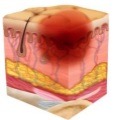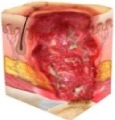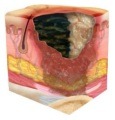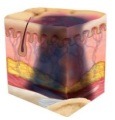Pressure Ulcer
WHAT IS PRESSURE ULCER?
CAUSES
- Pressure: Blood flow to tissues can be reduced if there is continual pressure on any side of the body. A lack of blood supply causes tissues to not get vital resources like oxygen and other nutrients, which causes them to become damaged and maybe die.
- Friction is caused when skin rubbing against clothing or bedding causes skin injury and raises the incidence of bedsores, especially in thin people with fragile skin and poor circulation.
- When two surfaces move in the opposing direction, shear happens.
STAGES OF PRESSURE ULCER
Stage1
Pressure ulcers typically appear as intact skin with localised, semi redness over a bone. Darkly pigmented skin may not pale visibly and may have a different colour from the surrounding skin. In comparison to surrounding tissue, the region may be painful, hard, soft, warmer, or cooler.

Stage2
Pressure ulcers are distinguished by a partial loss of dermal thickness and present as a shallow open ulcer with a reddish-pink wound bed that lacks slough. Others could appear as an intact or an open or ruptured blister filled with serum. Skin rips, tape burns, pericardial dermatitis, maceration, or excoriation should not be referred to as this stage.

Stage 3
There is full-thickness tissue loss in pressure ulcers. Bone, tendon, or muscle are not apparent, although subcutaneous fat may be. Slough might be visible, but it doesn’t hide how much tissue has been lost. Pressure ulcers in stage III may exhibit tunnelling and undermining.

Stage 4
Full thickness tissue loss with exposed bone, tendon, or muscle are signs of a stage IV pressure ulcer. Some areas of the wound bed may have eschar or slough. Stage IV pressure ulcers may entail tunnelling and undermining.

Unstageable Pressure
If the base of a pressure ulcer is covered by eschar or slough, it should be classified as unstageable. It is impossible to establish the sort of depth or stage of the wound until enough slough and/or eschar have been removed to expose the wound’s structure.

Deep Tissue Pressure
When underlying soft tissue is damaged by pressure and/or shear, it might result in a purple or maroon localised region of discoloured intact skin or a blood blister. Compared to nearby tissue, the area may be preceded by tissue that is painful, hard, spongy, swampy, warm, or cool.

Symptoms
- Unusual changes in skin colour or texture
- Swelling
- Pus-like draining
- An area of skin that feels cooler or warmer to the touch than other
areas - Tender areas
Prevention
Repositioning in a bed
- Change your weight frequently.
- And maybe you can, improve yourself.
- Explore specialised wheelchairs
- Choose pillows or a mattress that provides pressure relief.
- Change the height of your bed.
Tips for skin care
- Keep skin dry and clean.
- Protect your skin by regularly checking it.


